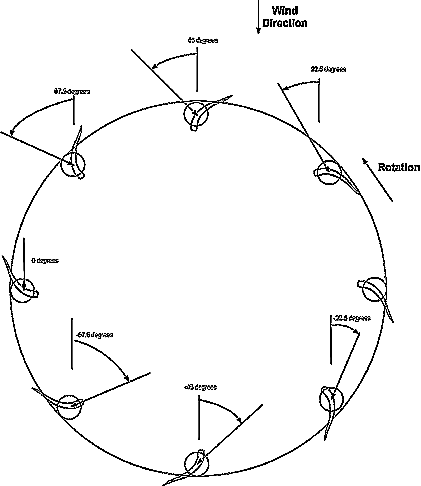Wind Technology
Wind Turbines
The turbines that are discussed on this website use a Savonius style configuration. The major benefit of the Savonius rotor is that it is self-starting and starts in low winds. This allows our users to wring as much out of their wind conditions as is possible for a given wind swept area.
This technology can be scaled upward and downward scaling in size, number of blades, solidity (i.e. number of blades), and so on. Because the blades are configured in the Savonius style, the turbine is drag dominated. It achieves a Tangential Speed Ratio (TSR) of less than one. The rotor will never over-speed and will survive winds up to 100 mph.
See the power curve for the VAWT 5000.
The coefficient of performance (Cp) is 42% allowing the 5KW VAWT to achieve a daily average of 24 killowatt-hours in a Class 3 wind region. This is possible because there is no "dead band" of wind energies such as Darrieus-type turbines experience at TSRs of .7 or so. A scenario that has been used on Darrieus wind turbines is to attach a Savonius type turbine to the shaft to start up the Darrieus through this dead band.
Horizontal Axis Wind Turbines (HAWTs)
HAWTs have very low torque profiles at low TSRs and usually need at least 5 m/s winds to start up. Historically, these turbines have been developed for high wind areas of Class 4 and above. They are much more powerful so to take advantage of the power in the higher winds. New HAWTs are designed for greater than 1 MW and have towers that loom up to 70 meters and more.
While there are companies that produce smaller turbines, the main market for HAWTs are for large wind farms. There is a proidious growth for this application.
Because they do not start in low winds, they are usually placed on tall towers. This represents a drawback for citizens in the surrounding areas, since they are considered to be an eyesore and an earsore. They are very noisy, creating a swoosh sound as they achieve their design RPPs. In addition, the large rotor blade tend to kill birds. In fact, approximately 100 raptors are killed each year at Altamont Pass in California. Be that as it may, most of the investment in wind technology has been for HAWTs.
Vertical Axis Wind Turbines
One argument for HAWTs is their scalability. An increase in rotor diameter provides a squared increase in wind swept area, and thus, wind power. In other words, doubling the radius of a HAWT would give a factor of 4 increase in power. An increase in turbine diamter for a VAWT only provides a linear increase. However, a VAWT also increases the height of the turbine blades by the same factor. For instance, a doubling of diameter for a VAWT provides a factor of 4 in swept area and the same factor of 4 increase in wind power.
VAWTs do not compete with HAWTs for very high energies in high winds. Instead, they take advantage of their ability to harvest energy from low wind areas. Thus they provide uses for applications that are not suitable for HAWTs, mainly for low-wind areas. Although they are designed for Class 3 wind regions, they will continue to produce power in Class 4 and above.

Savonius Rotor
PacWind's current offerings use the Savonius configuration. These turbines are drag dominated and will not achieve TSRs greater than unity. The profile for a 45 degree blade pitch at a TSR of unity
is shown to the right.
This configuration develops positive torque from low wind speeds. TSR will approach unity as the wind velocity increases. The turbine will accelerate until the torque equals the sum of the counter torque of friction and the back emf of the generator. This means, for a Savonius, that the torque peaks at some value of turbine velocity and then decreases. Thus the torque curve has a peak at lower velocities and decreases until equilibrium is reached.
The expression for power is P = tw where t is the torque and w is the angular velocity.
If the load is increased, the turbine velocity will decrease to establish a new equilibrium. This point will be where the turbine is developing more power as it reacts to the load demand. The TSR will decrease as higher power is demanded.
Axial Flux, Direct Drive Generator
The reliability of these VAWT wind turbines can be greatly enhanced by the use of direct drive generators. There are no slip rings, belts, or gears to wear out. In this design, there is only one moving part - the rotor.
The generator uses rare earth, permanent magnets (Ni-clad NdFeB). In the design for the VAWT 5000 and the Seahawk, we use 36 positive-negative pairs, counterpoised on two rotors. These field magnets sweep the field coils, arranged in 3 groups - 9 per phase. The size and strength of the magnets, the gauge of the field windings, and the number of turns are designed to deliver power in the most useful range of the turbine.
The phase windings are connected in a delta configuration and rectified. Although the power is very low at 2 m/s, the line voltage is 12 volts at that wind velocity and begins to charge 12 volt batteries.
Contact us to discuss the exciting ways that we can help you at REM Enterprises.
|